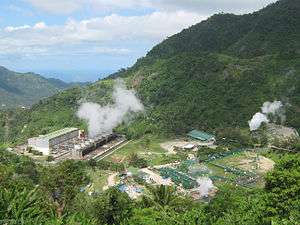Geothermal power in the Philippines

The Geothermal Education Office and a 1980 article titled "The Philippines geothermal success story" by Rudolph J. Birsic published in the journal Geothermal Energy note the remarkable geothermal resources of the Philippines.[1][2] During the World Geothermal Congress 2000 held in Beppu, Ōita Prefecture of Japan held from May to June 2000, it was reported that the Philippines is the largest consumer of electricity from geothermal sources and highlighted the potential role of geothermal energy in providing energy needs for developing countries.[3]
According to the International Geothermal Association (IGA), worldwide, the Philippines ranks second to the United States in producing geothermal energy. As of 2010, the US had a capacity of 3093 megawatts of geothermal power, while that of the Philippines was 1904 megawatts. The Philippines was followed by Mexico with 958 MW.[4] Early statistics from the Institute for Green Resources and Environment stated that Philippine geothermal energy provides 16% of the country's electricity.[5] By 2005, geothermal energy accounted for 17.5% of the country's electricity production.[6] More recent statistics from the IGA show that combined energy from the nation's six geothermal fields, located in the islands of Luzon, Leyte, Negros and Mindanao, still accounts for approximately 17% of the country's electricity generation. Leyte island is where the first geothermal power plant, a 3 megawatt wellhead unit, started operations in July 1977.[2] Larger-scale commercial production of geothermal power began in 1979 with the commissioning of a 110-megawatt plant at Tiwi field in Albay province. IGA figures [7] as of December 2009 show the nation's installed geothermal capacity stands at 1904 megawatts, with gross generation of 10,311 gigawatt-hrs for all of 2009, representing 17% of the nation's total power generation mix.
See also
- Renewable energy in the Philippines
- Wind power in the Philippines
- List of Geothermal power plants in the Philippines
References
- ↑ Geothermal Education Office - The Philippines
- 1 2 Birsic, R.J. The Philippines geothermal success story Geothermal Energy (vol. 8, Aug.-Sept. 1980, p. 35-44)
- ↑ World Geothermal Congress 2000
- ↑ IGA electricity generation for Mexico
- ↑ Institute for Green Resources and Environment: Asian Geothermal Symposium
- ↑ "International Energy Agency, Energy Statistic - Electricity/Heat in Philippines in 2005". Retrieved 2007-04-24.
- ↑ http://www.geothermal-energy.org/216,welcome_to_our_page_with_data_for_philippines.html
